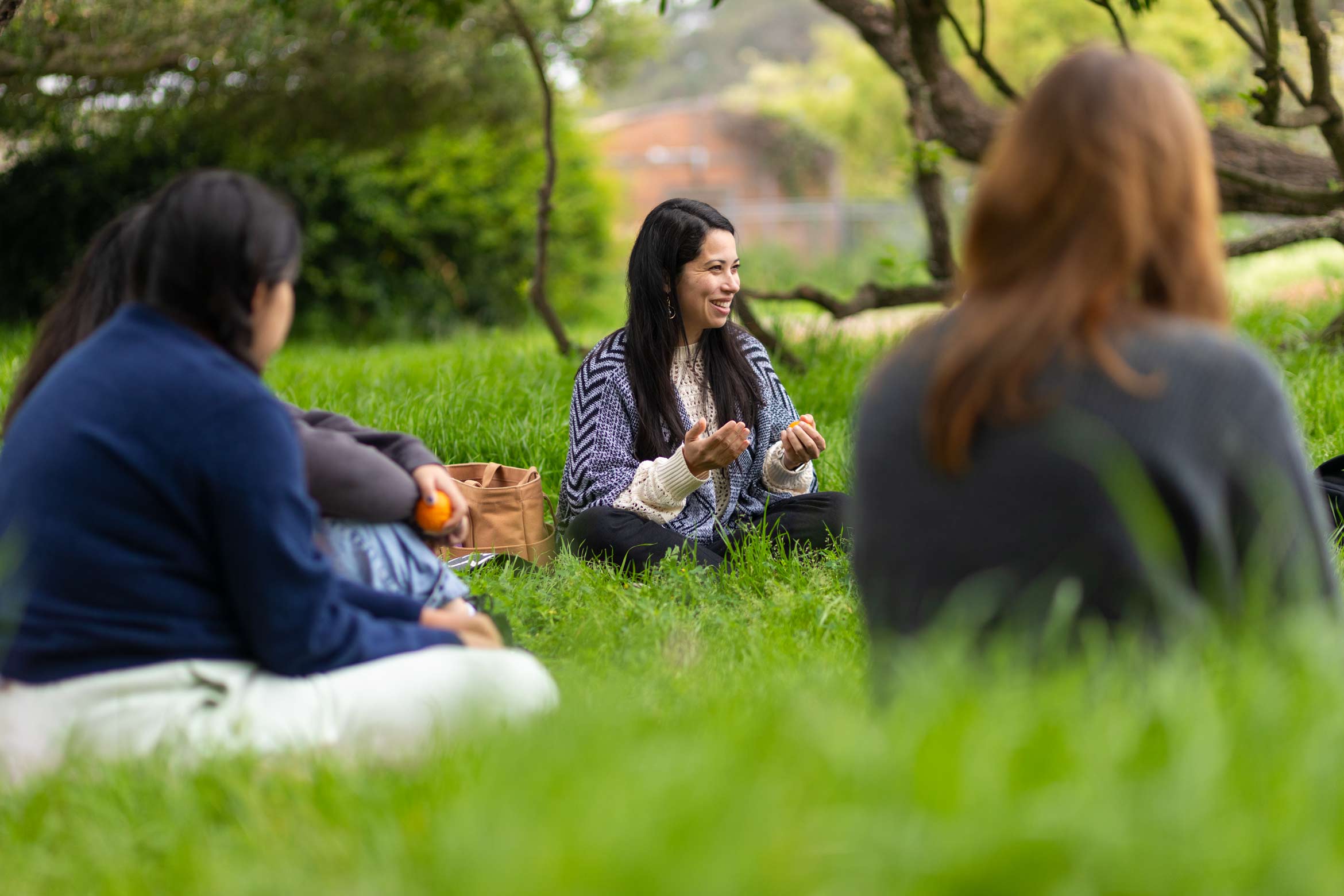
At the Estero Park open space in Isla Vista, environmental studies assistant professor Summer Gray (above) leads a gathering of UC Santa Barbara students enrolled in the newly offered UC-wide Climate Resilience Course.
PHOTOS: MATT PERKO

At the Estero Park open space in Isla Vista, environmental studies assistant professor Summer Gray (above) leads a gathering of UC Santa Barbara students enrolled in the newly offered UC-wide Climate Resilience Course.
PHOTOS: MATT PERKO
by Keith Hamm
ON A FOGGY SPRING MORNING at the edge of a small grove of oaks, a circle of UC Santa Barbara students gathered for class. Eyes closed, they tuned into their immediate surroundings, a blend of birdsong, breeze off the ocean and the peppery scent of nearby nasturtium. For a few moments, they were steeped in the present, practicing a mindfulness to fend off the darkness of an unknown future and fortify their shared activism for a better world.
Launched in April at eight University of California campuses, including UCSB, the UC Climate Resilience Course was designed by leading scholars and psychiatrists to help students build a durable mindset against the often debilitating anxieties tied to climate change. While the Earth sciences have made it clear that the climate grows more severe and erratic as the planet slowly warms, the psychological toll has also emerged as a problem in need of solutions.
“Throughout my life, I have experienced environmental anxiety and depression, feeling as though I am grieving the natural environment,” says Jada Alexander, a fourth-year environmental studies major. “It’s extremely important that we take mental health as seriously as other parts of our lives, if not more so. Without mental stability, we cannot help anyone or anything, including our planet.”

Jada Alexander at campus point
PHOTO: MATT PERKO
Those overwhelming feelings of despair can often delay or derail efforts to take on mounting crises, says Summer Gray, a climate justice researcher and assistant environmental studies professor. New generations of students are also impacted on very personal levels, confused by climate misinformation, conflicted about having children, ashamed of their own resource consumption and belittled as too young to understand how the world works.
“We can help them get unstuck and show them that they have the agency to shift the power dynamic,” says Gray, who leads the course alongside English professor Ken Hiltner and practitioners Diana Hill, a clinical psychologist and UCSB alum, and Christy Peterson, a certified mindfulness meditation instructor and attorney. The mindfulness training complements in-class and online coursework on climate advocacy and communication and the best practices of activism, among other topics, with a final paper in which each student will contemplate, “What kind of changemaker do I want to be?”
“When I arrived at UCSB in 2006 and started teaching courses on the climate crisis, the challenge, to put it bluntly, was to get students to care,” Hiltner remembers. “This has dramatically changed.”
These days, according to polling data, a majority of young people from countries around the world feel “very or extremely worried” about the climate crisis and more than half reported sadness, anger, powerlessness and guilt, and that those feelings negatively impacted their daily lives.
The new challenge is addressing these anxieties, Hiltner says. “Honestly, that’s now job number one. Since the climate crisis may well be the greatest existential threat that our species has ever collectively faced, we need this new generation to be mobilized — not petrified into inaction.”

Practicing mindfulness in the face or wake of disaster dates back more than half a century to villages bombed during the Vietnam War, Hiltner adds. As humanitarian workers labored to rebuild destroyed communities, they often fell into hopelessness as the next wave of air raids erased their efforts. Frozen by despair, they learned to reset and carry on through the guidance of Buddhist monk and peace activist Thích Nhât Ha˙nh, who became known as the father of mindfulness.
After their meditative circle near the oak trees, the UCSB students explored the Estero Park open space in the heart of Isla Vista, the collegiate enclave that’s been a West Coast hub of peace activism since the 1960s. Nearby, community garden plots burst with leafy greens and ripe loquats next to an emerging help-yourself food forest of guava, plum and sapote. All of it, especially in the context of young students practicing mindfulness, served to remind and reinforce innate connections to natural realms worth protecting.
“What we are doing builds leadership in an unknown future,” Gray says. “There’s a lot of potential for this course to grow.”